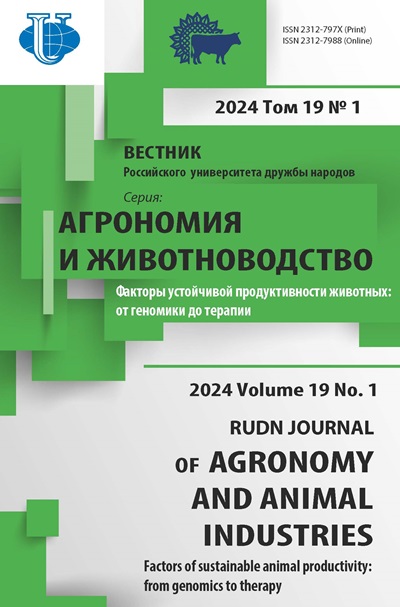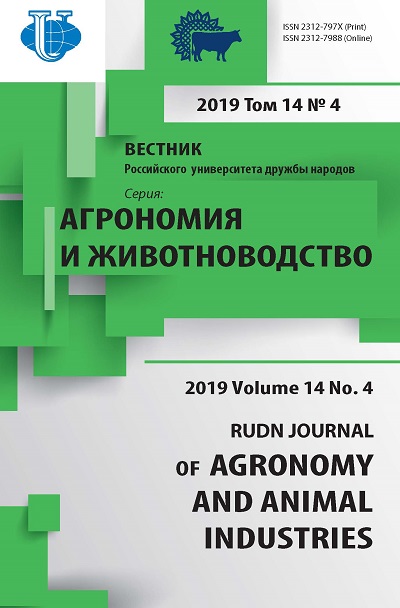GGE biplot analysis of Line by tester for seed yield and its attributes in sunflower
- Authors: Ahmed MA1, Abdelsatar M.A.1, Attia MA1, Abeer AA1
-
Affiliations:
- Agricultural Research Center
- Issue: Vol 14, No 4 (2019)
- Pages: 374-389
- Section: Genetics and plant breeding
- URL: https://agrojournal.rudn.ru/agronomy/article/view/19524
- DOI: https://doi.org/10.22363/2312-797X-2019-14-4-374-389
Cite item
Full Text
Abstract
About the authors
M A Ahmed
Agricultural Research Center
Email: mohamedtemraz1@yahoo.com
Oil Crops Research Department, Field Crops Research Institute Giza, Egypt
Mohamed Ali Abdelsatar
Agricultural Research Center
Email: mohamedtemraz1@yahoo.com
Senior Researcher, Oil Crops Research Department, Field Crops Research Institute Giza, Egypt
M A Attia
Agricultural Research Center
Email: mohamedtemraz1@yahoo.com
Oil Crops Research Department, Field Crops Research Institute Giza, Egypt
A A Abeer
Agricultural Research Center
Email: mohamedtemraz1@yahoo.com
Seed Technology Research Department, Field Crops Research Institute Giza, Egypt
References
- Yan W, Hunt LA, Sheng Q, Szlavnics Z. Cultivar evaluation and mega-environment investigation based on the GGE biplot. Crop Sci. 2000; 40(3):597-605. doi: 10.2135/cropsci2000.403597x
- Hladni N, Skoric D, Balalic KM, Sakac MZ, Miklie V. Heterosis for agronomically important traits in sunflower (Helianthus annuus L.). Helia. 2007; 30(47):191-198. doi: 10.2298/hel0747191h
- Škorić D, Jocić S, Hladni N, Vannozzi GP. An analysis of heterotic potential for agronomically important traits in sunflower (Helianthus annuus L.). Helia. 2007; 30 (46): 55-74.
- Hladni N, Miklic V, Jocic S, Balalic MK, Skoric D. Mode of inheritance and combining ability for plant height and head diameter in sunflower (Helianthus annuus L). Genetika. 2014; 46(1):159-168. doi: 10.2298/GENSR1401159H
- Memon S, Baloch MJ, Baloch GM, Keerio MI. Heritibility and correlation studies for phonological, seed yield and oil traits in Sunflower. Pakistan Journal of Agriculture, Agricultural Engineering and Veterinary Sciences. 2014; 30(2):159-171.
- Singh RK, Chaudhary BD. Biometrical methods in quantitative genetics analysis. New Delhi: Kalyani Publishers; 1985.
- Kempthorne O. An Introduction to Genetic Statistics. New York: John Wiley and Sons Inc; 1957.
- Comstock RE, Robinson HF. The components of genetic variance in populations of biparental progenies and their use in estimating the average degree of dominance. Biometrics. 1948; 4(4):254-266. doi: 10.2307/3001412
- Yan W, Hunt LA. Biplot analysis of diallel data. Crop Sci. 2002; 42(1):21-30. doi: 10.2135/cropsci2002.2100
- Bertoia L, Lopez C, Burak R. Biplot analysis of forage combining ability in maize landraces. Crop Sci. 2006; 46(3):1346-1353. doi: 10.2135/cropsci2005.09-0336
- Sassikumar D, Goplan A, Thirumurugan T. Combining ability analysis in Sunflower (Helianthus annuus L.). Tropical Agricultural Research. 1999; 11:134-142.
- Khan H, Rahman HU, Ahmad H, Ali H, Inamullah, Alam M. Magnitude of combining ability of sunflower genotypes in different environments. Pakistan Journal of Botany. 2008; 40(1):151-160.
- Andakhor SA, Mastibege N, Rameeh V. Combining ability of agronomic traits in sunflower (Helianthus annuus L.) using Line × Tester Analysis. International Journal of Biology. 2012; 4(1):89-95. doi: 10.5539/ijb.v4n1p89
- Abd El-Satar MA, Fahmy RM, Hassan THA. Genetic control of sunflower seed yield and its components under different edaphic and climate conditions. The 9th Plant Breeding International Conference September 2015, Egyptian Journal of Plant Breeding. 2015; 19(5):103-123 (Special Issue).
- Abd El-Satar MA. Genetic analysis of half diallel matting with different methods and their comparisons for yield and its associated traits in sunflower under saline soil stress conditions. Helia. 2017; 40(66):85-114. doi: 10.1515/helia-2017-0001
- Kang SA, Khan FA, Ahsan MZ, Chatha WZ, Saeed F. Estimation of combining ability for the development of hybrid genotypes in Sunflower (Helianthus annuus L). Journal of Biology, Agriculture and Healthcare. 2013; 3(1):68-74.
- Johnson HW, Robinson HF, Comstock RE. Estimates of genetic and environmental variability in Soybean. Agron J. 1955; 47:314-318.
- AOAC. Official Methods of Analysis. 15th ed. Virginia, USA: Association of Official Analytical Chemists; 1990.
















